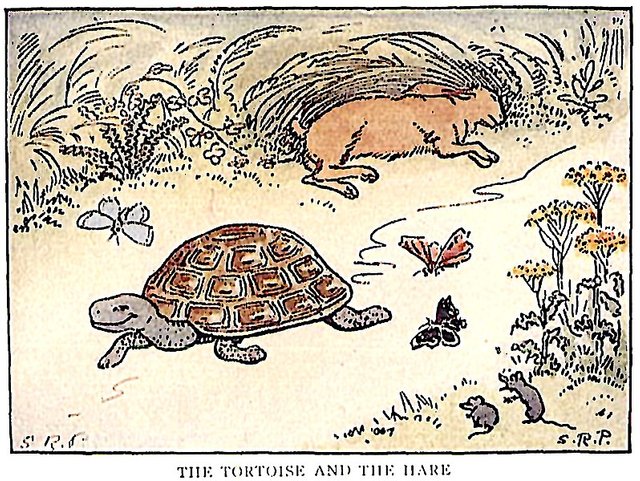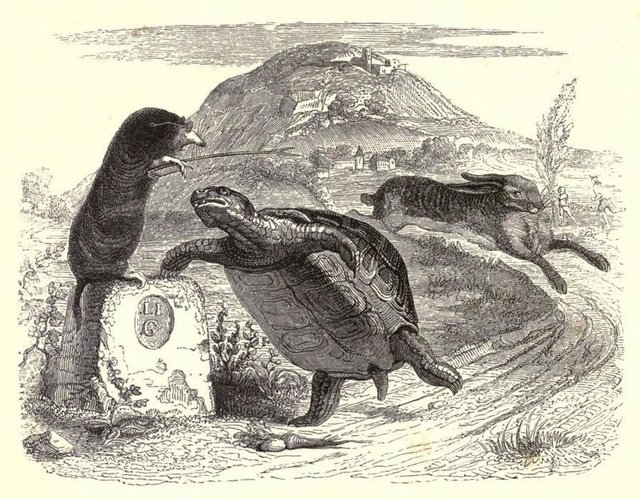What a Fable May Teach a Child. The Hare and the Tortoise

My own picture - Copy of The Unicorn Publishing House Aesop's Fables, illustrated by Walt Sturrock (1988)
Fearing a faulty generalization but trusting the average Steemian, I'd say,
Who doesn't heard of Aesop's fables, or read at least one?
Fables are known worldwide. You may not have read them directly from Aesop's, but it is highly probable, and more if you have been raised in western societies, that some of these tales are part of your encyclopedia. Say, "The Ant and the Grasshopper," "The Town Mouse and the Country Mouse," or the one I have chosen for this post: "The Hare and the Tortoise."
A traditional fable is a short narration, featuring anthropomorphic animals who go through events which teach them (and the reader) a lesson; this teaching or moral is explicitly stated at the end of the story.
(An anthropomorphic creature is that which has been given human qualities, like speaking, wearing clothes, arguing, etc…)
Although our parents, teachers, older siblings or parental figures in general may have read them to us from modern editions, or from La Fontaigne’s, it is Aesop we are supposed to consider the most famous fabulist (and storyteller) who ever existed although some of if not all of those fables might have been simply ascribed to him. By the way, we are talking about Ancient Greece, for the author lived around the VII-VI century before the Christian Era; hence, many details have been confused or lost along the years, as to determine the exact truth.
The first fable that I remember from my childhood is “The Hare and the Tortoise” by Aesop. I read it myself from my book in Spanish (“La Tortuga y la liebre”, Fábula de Esopo).
What happens in this fable?
“The hare, laughing, one day at the Tortoise for his slowness and general unwieldiness, was challenged by the latter to run a race. The hare, thinking this would be great fun, and a greater joke by far, consented […] The race began, and the Hare, of course, soon left the Tortoise behind. Having come midway to the end, [the Hare] began to play about..."

Image in the Public Domain (Wikimedia Commons - From Project Gutenberg)
She even took a nap, trusting she would easily overtake the Tortoise again. But she overslept, and when she finally reached the finish line, “she found that the Tortoise was already there, waiting for her arrival.”
At the end of the short narrative, you could see the moral, written in bigger font, imitating handwrite:
“La arrogancia hace perdedores”.
“Arrogance makes losers.”
However, in this version from the Unicorn Publishing House (as well as in the one by La Fontaine) the moral emphasizes the virtue of the Tortoise instead of the vice of the Hare:
“Slow and steady wins the race.”
“Quien va lento y constante gana la carrera”.
Scholars say this change of emphasis obeys the spirit of festina lente, by which you were encourage to proceed rather slowly always you felt you had to make haste. But in Aesop’s day, the stress was on the imprudent over-confidence of the Hare, which makes her lose even though she happened to be more qualified than the Tortoise for the appointed purpose.
Whatever the moral you choose, children understand that Hare’s behavior is not to be approved of. But children are also faced with ambiguity:
What if the Hare won the race even though her boasting and offensiveness (ridiculing the slow-moving, short-legged Tortoise); after all, she was ideally equipped to do so. What if, huh? But she doesn’t win; she can’t win because not all of the equipment you need to win is physical. Psychologically and morally, the Hare has been proven incompetent.
“Better not to boast and do your best.”
This seems a good way to go. Besides, you could always use your acknowledging the good qualities of others, for they may have what you are missing.
(Personally, I would leave the moral to be teased out by the readers, but fables are fables, I guess. Up to us!)

A 19th-century illustration of La Fontaine's Fables by Jean Grandvillee - Image in the Public Domain (Wikimedia Commons)
Posted from my blog with SteemPress : https://marlyncabrerawp.000webhostapp.com/2019/05/what-a-fable-may-teach-a-child-the-hare-and-the-tortoise

Thanks for reading about Children’s Literature.

Soy miembro de Talent Club.

To listen to the audio version of this article click on the play image.

Brought to you by @tts. If you find it useful please consider upvoting this reply.